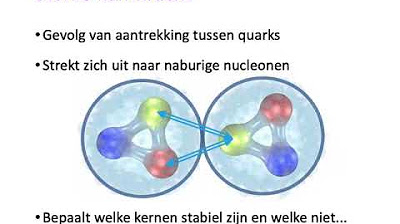The Four Forces of Nature
Summary
TLDRThis video explores the four fundamental forces of nature—gravity, the weak force, the electromagnetic force, and the strong force. It delves into their roles in everyday life, from the gravity that keeps us grounded to the weak force powering the sun. The script highlights the evolution of scientific understanding, from Galileo's discoveries to modern physics, and how these forces shape the universe. It also emphasizes the importance of continual scientific exploration and learning through hands-on experiences, promoting a growth mindset with tools like Brilliant for interactive learning.
Takeaways
- 😀 The word 'force' is widely used in both everyday life and scientific contexts, such as in government actions or a child's protest.
- 😀 Force is defined as a push or pull on an object resulting from its interaction with another object, and it is essential for all aspects of life.
- 😀 The four fundamental forces of nature—gravity, weak force, electromagnetic force, and strong force—are crucial to the universe's existence.
- 😀 Gravity is the most familiar force and was first correctly explained by Isaac Newton, showing that it pulls objects towards each other based on their mass.
- 😀 Gravity keeps planets in orbit around the sun and prevents us from easily leaving Earth, although it is a relatively weak force.
- 😀 The weak force is stronger than gravity at tiny distances, responsible for particle transformations, such as in beta decay, and is crucial for processes like nuclear fusion in stars.
- 😀 The electromagnetic force, combining electricity and magnetism, is responsible for everyday phenomena like friction, elasticity, and tension.
- 😀 Electromagnetic forces also explain how magnets and electric fields interact, such as in the ability to attach magnets to a refrigerator.
- 😀 The strong force is the most powerful of the four forces, binding protons and neutrons in atomic nuclei and preventing particles from flying apart.
- 😀 While the strong force is incredibly powerful, it operates only at extremely small distances within the atomic nucleus, and it's fundamental for the structure of matter.
- 😀 Scientific knowledge is ever-evolving, and discoveries, such as the connection between electricity and magnetism, are often the result of gradual shifts in understanding over time.
Q & A
What is the scientific definition of 'force'?
-Force is defined as the push or pull upon an object resulting from its interaction with another object.
How does gravity work and why is it essential?
-Gravity is a force that exists between all objects with mass, pulling them toward each other. It is essential because it keeps planets in orbit, prevents objects from flying off Earth, and enables life as we know it by keeping the Earth’s environment stable.
What discovery did Galileo make regarding gravity?
-Galileo discovered that objects thrown from the same height accelerate at a constant rate, and that all bodies fall with the same acceleration, provided air resistance and buoyancy are negligible.
How did Isaac Newton contribute to the understanding of gravity?
-Isaac Newton proposed that gravity is a force acting between objects with mass, pulling them towards each other. His theory provided a mathematical framework that explained the motion of planets and other celestial bodies.
What role does gravity play in our ability to travel to space?
-Gravity is a significant barrier to space travel. Its strong pull keeps us anchored to Earth, making it difficult to leave the planet. If gravity were weaker, we might have been able to settle on the Moon or Mars more easily.
What is the weak force, and where does it act?
-The weak force is a powerful force at very short distances, affecting subatomic particles. It is responsible for processes like beta decay, where one particle changes into another, such as Carbon-14 transforming into Nitrogen-14.
How does the weak force contribute to radiocarbon dating?
-The weak force causes Carbon-14 to decay into Nitrogen-14, which allows scientists to date fossils and significant historical events by measuring the amount of Carbon-14 remaining in a sample.
What is the electromagnetic force, and how was its connection to magnetism discovered?
-The electromagnetic force is the force that governs interactions between charged particles. Its connection to magnetism was discovered by Hans Christian Ørsted, who found that an electric current could influence a nearby compass, revealing the relationship between electricity and magnetism.
What is the importance of the normal force in daily life?
-The normal force is the force that keeps two surfaces in place, preventing them from collapsing or moving. It is why objects like a coffee mug stay on a desk rather than crashing through due to gravity.
Why is the strong force considered the most powerful force in nature?
-The strong force is the most powerful because it holds the nucleus of an atom together, overcoming the electrostatic repulsion between protons. It is millions of times stronger than the weak force, electromagnetism, and gravity.
Outlines

Этот раздел доступен только подписчикам платных тарифов. Пожалуйста, перейдите на платный тариф для доступа.
Перейти на платный тарифMindmap

Этот раздел доступен только подписчикам платных тарифов. Пожалуйста, перейдите на платный тариф для доступа.
Перейти на платный тарифKeywords

Этот раздел доступен только подписчикам платных тарифов. Пожалуйста, перейдите на платный тариф для доступа.
Перейти на платный тарифHighlights

Этот раздел доступен только подписчикам платных тарифов. Пожалуйста, перейдите на платный тариф для доступа.
Перейти на платный тарифTranscripts

Этот раздел доступен только подписчикам платных тарифов. Пожалуйста, перейдите на платный тариф для доступа.
Перейти на платный тарифПосмотреть больше похожих видео
5.0 / 5 (0 votes)






